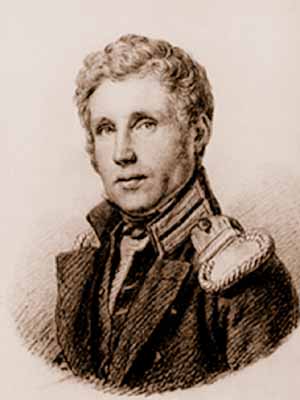Otto von Kotzebue facts for kids
Quick facts for kids
Otto von Kotzebue
|
|
|---|---|
 |
|
| Born | 30 December [O.S. 19] 1787 Reval, Harrien County, Governorate of Estonia, Russian Empire
|
| Died | 15 February [O.S. 3] 1846 (aged 58) Reval, Harrien County, Governorate of Estonia, Russian Empire
|
| Citizenship | Russian Empire, German Confederation |
| Parent(s) | August von Kotzebue |
Otto von Kotzebue was a Russian naval officer and explorer. He was born in Reval, which is now Tallinn, Estonia. Otto is famous for his important trips to explore the Pacific Ocean and Oceania.
Contents
Otto's Early Life and Training
Otto von Kotzebue was born in 1787 in Reval. This city is now called Tallinn, in Estonia. His father was a well-known writer and diplomat named August von Kotzebue.
Otto went to a special school for cadets in Saint Petersburg. After finishing school, he joined a big voyage. From 1803 to 1806, he sailed with another famous explorer, Adam Johann von Krusenstern. This early experience helped him become a great sailor.
Exploring the World
First Big Voyage (1815-1818)
After becoming a lieutenant, Otto von Kotzebue got his own command. He led an expedition on a small ship called the Rurik. This trip was paid for by Count Nikolay Rumyantsev.
On July 30, 1815, Kotzebue set sail. His goal was to find a passage through the Arctic Ocean. He also wanted to explore parts of Oceania that were not well known. His crew included only 27 men. Among them were scientists Johann Friedrich von Eschscholtz and Adelbert von Chamisso. An artist named Louis Choris also joined them.
They sailed around Cape Horn at the tip of South America. Along the way, they discovered several islands. These included the Romanzov Islands and Rurik Islands. They also found the Krusenstern Islands, which are now called Tikehau.
Next, they headed to Kamchatka in Russia. In July, they sailed north along the coast of North America. Here, Kotzebue discovered and named Kotzebue Sound and Cape Krusenstern. These places are in the cold Chukchi Sea.
After exploring the Asian coast, they sailed south again. They spent three weeks at the Sandwich Islands. On January 1, 1817, they discovered New Year Island.
Kotzebue continued exploring the Pacific Ocean. However, he became very ill. This forced him to return to Europe. He arrived back in Russia on August 3, 1818. He brought back many new plants and important information about different cultures.
Second Big Voyage (1823-1826)
In 1823, Kotzebue was a captain. He was given command of another expedition. This time, he led two warships. Their main job was to take supplies to Kamchatka.
Scientists joined this trip on the ship Enterprise. They gathered valuable information. This included details about geography, different cultures (ethnography), and natural history.
The expedition sailed around Cape Horn again. They visited the Radak and Society Islands. In July 1824, they reached Petropavlovsk.
During this voyage, they corrected many maps of the coast. They also visited the Navigator islands. They made several new discoveries. The expedition returned by way of the Marianas, Philippines, New Caledonia, and the Hawaiian Islands. They arrived back in Russia on July 10, 1826.
Kotzebue wrote books about both of his voyages. His first book was called A Voyage of Discovery into the South Sea and Bering’s Straits. His second was A New Voyage Round the World. Both books were translated into English.
In his later years, Kotzebue lived in Estonia. He passed away in Reval (Tallinn) in 1846. He was buried in the Kose churchyard. His grave has a large monument.
His Lasting Impact
Otto von Kotzebue left a lasting mark on the world.
- Kotzebue Sound and the city of Kotzebue, Alaska are named after him.
- Kotzebue Street in Tallinn, Estonia, is named after him and his father.
- A type of butterfly, the Pachliopta kotzebuea, was named after him. It was named by Johann Friedrich von Eschscholtz, a scientist on the Rurik.
See also
 In Spanish: Otto von Kotzebue para niños
In Spanish: Otto von Kotzebue para niños

